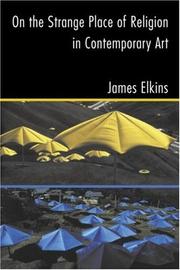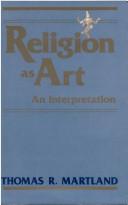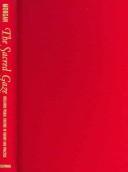| Listing 1 - 10 of 83 | << page >> |
Sort by
|
Book
Year: 2011 Publisher: Bruxelles : Éditions de l'Université de Bruxelles,
Abstract | Keywords | Export | Availability | Bookmark
 Loading...
Loading...Choose an application
- Reference Manager
- EndNote
- RefWorks (Direct export to RefWorks)
Quels que soient le lieu ou la civilisation que l'on explore, des relations profondes entre religion et art se décèlent. L'art traduit volontiers les aspects des fonctions religieuses, soit dans le cadre organisé d'un rituel, soit plus spontanément, dans l'expression de la foi personnelle ou collective. Les religions font appel aux artistes pour rendre apparent et intelligible l'invisible mais se heurtent souvent à eux en leur imposant des formes. Mais si bien des civilisations ont fait l'objet d'études fouillées sur la manière dont elles articulaient l'art et la religion, force est de constater que très peu de chercheurs se sont attelés à une vue transversale de ces notions. Cet ouvrage s'inscrit dès lors dans une perspective comparative ayant pour but de souligner les diachronies et les spécificités religieuses.
Book
Year: 2015 Publisher: Firenze Firenze University Press
Abstract | Keywords | Export | Availability | Bookmark
 Loading...
Loading...Choose an application
- Reference Manager
- EndNote
- RefWorks (Direct export to RefWorks)
This research offers an integral analysis of the aesthetic thought of the director, playwright and art theorist Nikolaj Nikolaevic Evreinov. The work focuses on the analysis of the treaty The revelation of art, written in Paris in the 1930s, which represents the greatest testimony of the author's research in the aesthetic field. Henceforth, a connection is offered between the known aspects of Evreinov's theatrical thought, relating to the period of the avant-garde in Russia, and others, of a broader nature, which have long been precluded from being known. Through insights on the Russian theatrical history of the early 20th century, reflections touching textual criticism, the history of aesthetic thought and Russian criticism, the complex figure of an artist emerges against the background of the culture expressed by post-revolutionary Russian emigration. An artist who, as an intellectual, begins a dialogue with the Western European cultural tradition. This book thus intends to restore the visibility, as well as an exegetical and historiographic completeness, of Evreinov's rich legacy as a writer, a philosopher and a critic.
Book
ISBN: 9004447598 9789004447592 9789004447431 Year: 2020 Publisher: Leiden ; Boston : Brill,
Abstract | Keywords | Export | Availability | Bookmark
 Loading...
Loading...Choose an application
- Reference Manager
- EndNote
- RefWorks (Direct export to RefWorks)
This slim volume offers a thematic exploration of religion and the digital arts. Over the course of six brief sections, this extended essay examines identity and community, authority and authenticity, word and image, ritual and practice, body and space, and myth and faith. Each of these paired sets is explored in concert with technologically inflected correlates. For instance, identity and community are paired with avatars and networks. These twin concepts provide the thematic anchor of each section. Each section looks at four works of digital art with each work employing digital technology in a unique way. The works include virtual and augmented reality pieces, 3D printed sculptures, digital photography, and digitally enabled performance pieces and installations and span the late 1990s to the present. This essay is an introduction to religion and the digital arts and, while no single conclusion can be drawn from such an expansive and diverse field, the reassertion of the religious and theological importance of the body and emotions in the face of digital technology emerges as a recurrent theme.
Book
ISBN: 1135902321 1281796522 9786611796525 020389166X Year: 2009 Publisher: New York : Routledge,
Abstract | Keywords | Export | Availability | Bookmark
 Loading...
Loading...Choose an application
- Reference Manager
- EndNote
- RefWorks (Direct export to RefWorks)
The near-absence of religion from contemporary discourse on art is one of the most fundamental issues in postmodernism. Artists critical of religion can find voices in the art world, but religion itself, including spirituality, is taken to be excluded by the very project of modernism. The sublime, ""re-enchantment"" (as in Weber), and the aura (as in Benjamin) have been used to smuggle religious concepts back into academic writing, but there is still no direct communication between ""religionists"" and scholars. Re-Enchantment, volume 7 in The Art Seminar Series, will be the first
Book
ISBN: 1621897524 9781621897521 Year: 2013 Publisher: Eugene, Oregon : Cascade Books,
Abstract | Keywords | Export | Availability | Bookmark
 Loading...
Loading...Choose an application
- Reference Manager
- EndNote
- RefWorks (Direct export to RefWorks)
As an artist, Deborah Sokolove has often been surprised and dismayed by the unexamined attitudes and assumptions that the church holds about how artists think and how art functions in human life. By investigating these attitudes and tying them to concrete examples, Sokolove hopes to demystify art--to bring art down to earth, where theologians, pastors, and ordinary Christians can wrestle with its meanings, participate in its processes, and understand its uses. In showing the commonalities and distinctions among the various ways that artists themselves approach their work, Sanctifying Art can help the church talk about the arts in ways that artists will recognize. As a member of both the church and the art world, Sokolove is well-positioned to bridge the gap between the habits of thought that inform the discourse of the art world and those quite different ideas about art that are taken for granted by many Christians. When art is understood as intellectual, technical, and physical as well as ethereal, mysterious, and sacred, we will see it as an integral part of our life together in Christ, fully human and fully divine.

ISBN: 1135879710 1280063181 0203324862 9780203324868 9780415969888 0415969883 9780415969895 0415969891 9786610063185 6610063184 9781135879716 9781135879662 1135879664 9781135879709 1135879702 9781280063183 0415969891 0415969883 Year: 2004 Publisher: New York : Routledge,
Abstract | Keywords | Export | Availability | Bookmark
 Loading...
Loading...Choose an application
- Reference Manager
- EndNote
- RefWorks (Direct export to RefWorks)
For millennia, art has been religious - even in times and places when there was no word for 'art'. Then, in the Renaissance, it became possible for art to glorify the artist, making viewers think more of his skills than of the subjects he portrayed. The modern artist faces a more complex dilemma - one that no art historian has talked about until now.Can contemporary art say anything about spirituality? Is contemporary art is spiritual? What might it mean to say that the art you make expresses your spiritual belief?The Impossibility of Transcendence is about the curious disconnect between spir
Art and religion. --- Modernism (Art) --- Art --- Study and teaching (Higher) --- Art and religion
Book
ISBN: 3657777083 Year: 2014 Publisher: Paderborn : Ferdinand Schöningh,
Abstract | Keywords | Export | Availability | Bookmark
 Loading...
Loading...Choose an application
- Reference Manager
- EndNote
- RefWorks (Direct export to RefWorks)
Eine Skulptur des Künstlers Stephan Balkenhol im Turm der St. Elisabeth-Kirche in Kassel empfand die Leitung der zeitgleich stattfindenden dOCUMENTA (13) als Provokation: das Werk greife massiv in den Rezeptionsraum der eigenen Ausstellung ein. Der Vorwurf löste eine kontroverse Diskussion über die kirchlichen Begleitausstellungen zur documenta aus. Der vorliegende Band beschreibt die umstrittenen kirchlichen Kunstprojekte, die während der verschiedenen documenta-Ausstellungen durchgeführt wurden; er enthält Beiträge von Kunstwissenschaftlern und Theologen zur Kunst von Stephan Balkenhol sowie zur Autonomie der Kunst und ihrem Verhältnis zur Kirche. In einem ausführlichen Gespräch äußert sich Stephan Balkenhol selbst zu seiner Ausstellung in der St. Elisabeth-Kirche und zu der von ihr ausgelösten Kontroverse.
Art and religion. --- Christian art and symbolism. --- Documenta (Exhibition)

ISBN: 0585093083 9780585093086 087395520X 0873955218 1438412134 9780873955201 9780873955218 Year: 1981 Publisher: [Place of publication not identified] State University of New York Press
Abstract | Keywords | Export | Availability | Bookmark
 Loading...
Loading...Choose an application
- Reference Manager
- EndNote
- RefWorks (Direct export to RefWorks)
Art and religion --- Visual Arts - General --- Visual Arts --- Art, Architecture & Applied Arts --- Art --- Arts in the church --- Religion and art --- Religion --- Religious aspects --- Art and religion.

ISBN: 1282763148 9786612763144 0520938305 1417585102 9780520938304 1597349461 9781597349468 9780520925618 0520925610 0520242874 9780520242876 0520243064 9780520243064 9781282763142 Year: 2005 Publisher: Berkeley : University of California Press,
Abstract | Keywords | Export | Availability | Bookmark
 Loading...
Loading...Choose an application
- Reference Manager
- EndNote
- RefWorks (Direct export to RefWorks)
""Sacred gaze"" denotes any way of seeing that invests its object-an image, a person, a time, a place-with spiritual significance. Drawing from many different fields, David Morgan investigates key aspects of vision and imagery in a variety of religious traditions. His lively, innovative book explores how viewers absorb and process religious imagery and how their experience contributes to the social, intellectual, and perceptual construction of reality. Ranging widely from thirteenth-century Japan and eighteenth-century Tibet to contemporary America, Thailand, and Africa, The Sacred Gaze
Art and religion. --- Art --- Arts in the church --- Religion and art --- Religion --- Religious aspects
Book
ISBN: 1621895890 9781621895893 162032475X 9781620324752 Year: 2013 Publisher: Eugene, Oregon : Resource Publications,
Abstract | Keywords | Export | Availability | Bookmark
 Loading...
Loading...Choose an application
- Reference Manager
- EndNote
- RefWorks (Direct export to RefWorks)
Suitable for Advent or Lent, these meditations on pictorial images of light are navigational aids in the ascent to trust in the triumph. In a relatively late in life synthesis of her interests in art and religion, Sharon R. Chace explores art that evokes the light of a star, inclusion, forgiveness, caring, healing, speaking truth to power, transfiguration, and resurrection. Questions for individual or group consideration invite further reflection and discussion about the art and personal experiences. Living in the light is a way to participate in God-like healing love. Being lights in the world can help one another sustain trust in the implicit meaning of Christmas and Easter that is in the prologue of the Gospel of John (1: 1-5). The Gospel writer concludes with a declarative sentence of promise: "The light shines in the darkness, and the darkness did not overcome it."
Art and religion. --- Art --- Arts in the church --- Religion and art --- Religion --- Religious aspects
| Listing 1 - 10 of 83 | << page >> |
Sort by
|

 Search
Search Feedback
Feedback About UniCat
About UniCat  Help
Help News
News